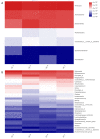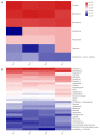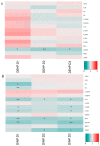Impact of Plasticizer on the Intestinal Epithelial Integrity and Tissue-Repairing Ability within Cells in the Proximity of the Human Gut Microbiome
- PMID: 36767519
- PMCID: PMC9915929
- DOI: 10.3390/ijerph20032152
Impact of Plasticizer on the Intestinal Epithelial Integrity and Tissue-Repairing Ability within Cells in the Proximity of the Human Gut Microbiome
Abstract
Toxicological research into the impact of plasticizer on different organs has been reported in the past few decades, while their effects on shifting the gut microbiota and immune cells homeostasis in zebrafish were only studied recently. However, studies on the impact of plasticizer on human gut microbiota are scarce. In this study, we co-incubated healthy human fecal microbiota with different concentrations of Di(2-ethylhexyl) phthalate (DEHP) and di-iso-nonyl phthalate (DINP), analyzed microbial composition by 16S rDNA sequencing, and compared the influence of their derived microbiomes on the human enterocyte (HT-29) and murine macrophage (RAW264.7) cell lines. Microbial diversity is reduced by DEHP treatment in a dose-dependent manner. DEHP treatment reduced the phyla Firmicutes/Bacteroidetes ratio, while DINP treatment promoted Proteobacteria. Expressions of tight/adherens junction genes in HT-29 and anti-inflammatory genes in RAW264.7 were down-regulated by plasticizer-co-incubated microbiota derived metabolites. Overall, it is observed that selected plasticizers at high dosages can induce compositional changes in human microbiota. Metabolites from such altered microbiota could affect the tight junction integrity of the intestinal epithelium and upset macrophage differentiation homeostasis in proximity. Chronic exposure to these plasticizers may promote risks of dysbiosis, leaky gut or the exacerbation of intestinal inflammation.
Keywords: di(2-ethylhexyl) phthalate (DEHP); di-iso-nonyl phthalate (DINP); dysbiosis; gut microbiota; intestinal epithelial cell; intestinal inflammation; leaky gut; macrophage; phthalate plasticizer.
Conflict of interest statement
The authors declare no conflict of interest.
Figures









Similar articles
-
Disrupting the gut microbiota/metabolites axis by Di-(2-ethylhexyl) phthalate drives intestinal inflammation via AhR/NF-κB pathway in mice.Environ Pollut. 2024 Feb 15;343:123232. doi: 10.1016/j.envpol.2023.123232. Epub 2024 Jan 1. Environ Pollut. 2024. PMID: 38171427
-
Gut microbiota dysbiosis might be responsible to different toxicity caused by Di-(2-ethylhexyl) phthalate exposure in murine rodents.Environ Pollut. 2020 Jun;261:114164. doi: 10.1016/j.envpol.2020.114164. Epub 2020 Feb 14. Environ Pollut. 2020. PMID: 32088434
-
Long-term chronic exposure to di-(2-ethylhexyl)-phthalate induces obesity via disruption of host lipid metabolism and gut microbiota in mice.Chemosphere. 2022 Jan;287(Pt 4):132414. doi: 10.1016/j.chemosphere.2021.132414. Epub 2021 Sep 29. Chemosphere. 2022. PMID: 34600010
-
An insight into the critical role of gut microbiota in triggering the phthalate-induced toxicity and its mitigation using probiotics.Sci Total Environ. 2023 Dec 15;904:166889. doi: 10.1016/j.scitotenv.2023.166889. Epub 2023 Sep 6. Sci Total Environ. 2023. PMID: 37683852 Review.
-
Toxicological quandary of the use of bis (2-diethylhexyl) phthalate (DEHP) as a plasticizer for blood bags.Ann Clin Lab Sci. 1988 Mar-Apr;18(2):131-40. Ann Clin Lab Sci. 1988. PMID: 3289468 Review.
References
-
- Hogberg J., Hanberg A., Berglund M., Skerfving S., Remberger M., Calafat A.M., Filipsson A.F., Jansson B., Johansson N., Appelgren M., et al. Phthalate diesters and their metabolites in human breast milk, blood or serum, and urine as biomarkers of exposure in vulnerable populations. Environ. Health Perspect. 2008;116:334–339. doi: 10.1289/ehp.10788. - DOI - PMC - PubMed
Publication types
MeSH terms
Substances
LinkOut - more resources
Full Text Sources
Miscellaneous

